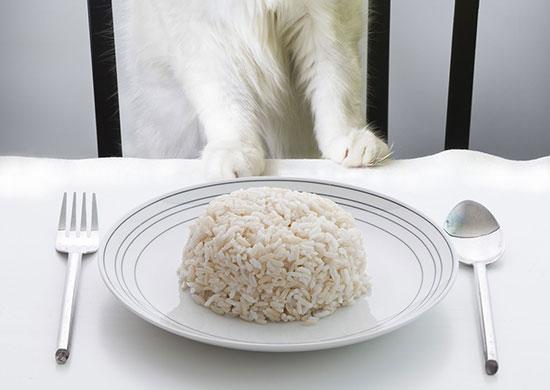This content is archived from the Feline Nutrition Foundation
Rice Isn't Nice
- Updated: Saturday, June 01, 2019 05:12 PM
- Published: Monday, September 14, 2009 11:38 AM
- Written by Margaret Gates
 I've been noticing something when I walk down the pet aisle at the supermarket. It's just to get kitty litter mind you, since I don't believe there is any real cat food there. A lot of those cans and bags are touting the fact that they contain rice. It seems it's is the new "in" filler. Wheat has gotten a bit of a bad reputation lately, mostly because it turns out some people have trouble with it, and pet owners are getting the message that corn is bad for cats. Pet food companies seem to be left with rice.
I've been noticing something when I walk down the pet aisle at the supermarket. It's just to get kitty litter mind you, since I don't believe there is any real cat food there. A lot of those cans and bags are touting the fact that they contain rice. It seems it's is the new "in" filler. Wheat has gotten a bit of a bad reputation lately, mostly because it turns out some people have trouble with it, and pet owners are getting the message that corn is bad for cats. Pet food companies seem to be left with rice.
Many people buy pet food based on the sound of the name. I'm not making a judgment. I, too, fell for the pet food marketing strategies at one time. It's easy to market, perhaps easier than other grains. All those meats sound so appetizing paired with it: "Tender Turkey Tuscany in a Savory Sauce with Long Grain Rice and Garden Greens."¹ Sounds like something I would eat for dinner. Now, if my cat could read labels, this is more like what she would find appealing: "Raw Brains and Heart in Fresh Blood with a Crunchy Chopped Grasshopper Garnish."
As obligate carnivores, cats have no nutritional requirement for grains of any sort.² If it's an ingredient, it's a filler, plain and simple. A study by The American Society for Nutritional Sciences showed dietary rice decreases the amount of taurine in whole blood and plasma in cats. Despite routine supplementation of commercial feline diets with taurine, cats continue to be diagnosed with taurine deficiency. Its presence in the food affects the content of fat and fiber, which in turn could affect the metabolism of taurine. To quote from the study, "Diet formulations with normally adequate taurine supplementation may actually be deficient in taurine if rice bran or whole rice is included as an ingredient."
As if this weren't bad enough, many products contain brewer's rice, which is "the small milled fragments of rice kernels that have been separated from the larger kernels (AAFCO definition)."³ It's used because it's the lowest quality by-product of the milling process and is cheaper.⁴ Remember, the massive 2007 pet food recall involved foods that contained imported rice protein and wheat gluten adulterated with melamine.⁵
Additional Reading
Adding Taurine to a Raw Cat Food Diet
Then there are all those foods with wild rice. I think they just love to get that word "wild" on a cat food label. It conjures up all those big cat associations. You know, stalking prey in the jungle and all that. Those cats aren't looking to pounce on the elusive wild rice plant.
If you read a cat food label and it sounds good enough to eat, it's probably not good enough for your cat.
Margaret Gates is the founder of the Feline Nutrition Foundation.
1. Purina® Fancy Feast® Elegant Medleys®.
2. Kymythy R Schultze, CN, CNC, Natural Nutrition for Cats, The Path to Purr-fect Health, Hay House Inc, 2008, 145.
3. "Brewers Rice," Association Of American Feed Control Officials, definition at Wikipedia.
4. "Broken Rice," Multigrain Group.
5. "Melamine Pet Food Recall – Frequently Asked Questions," U.S. Food and Drug Administration, August 1, 2007.




